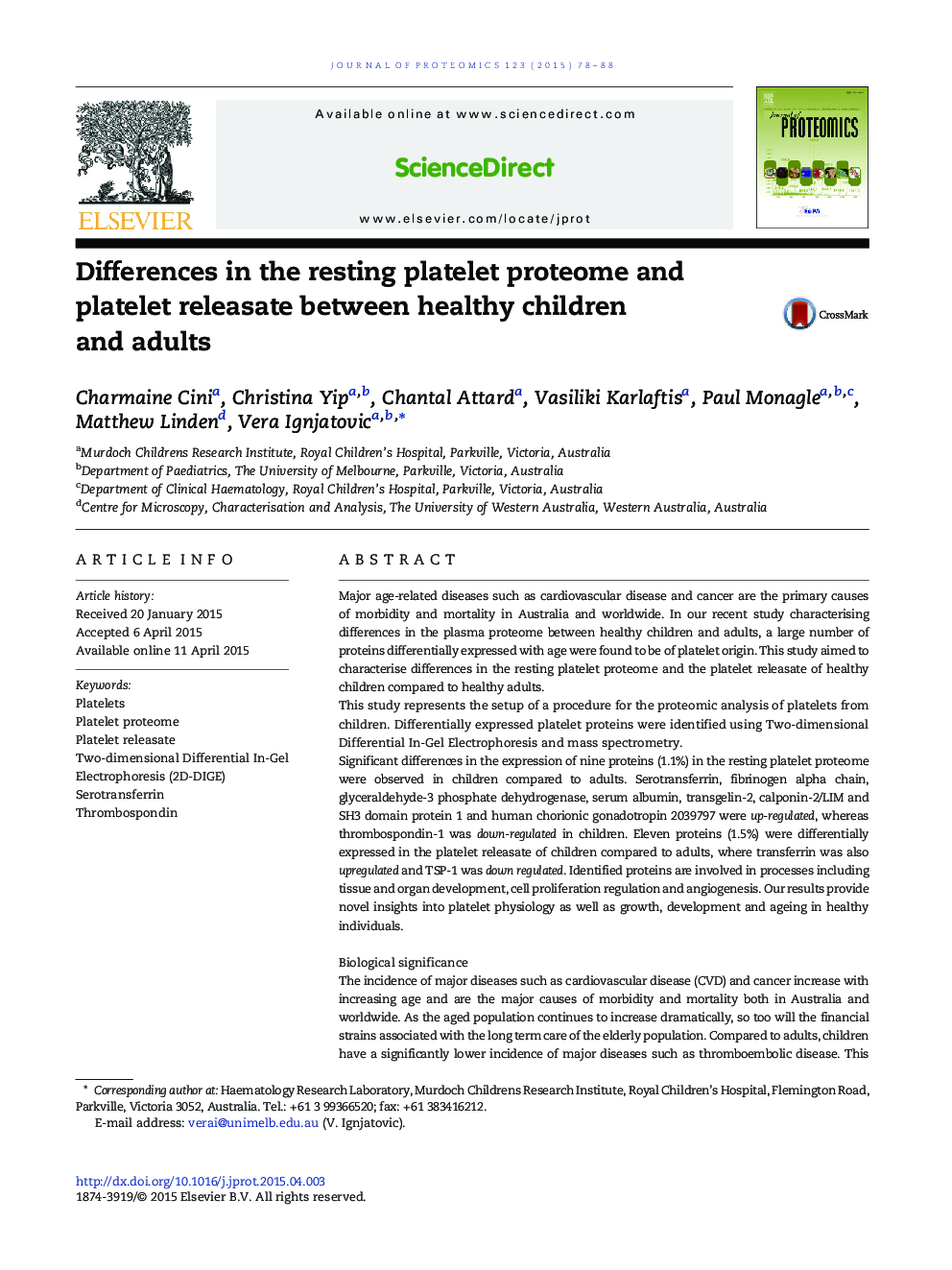| کد مقاله | کد نشریه | سال انتشار | مقاله انگلیسی | نسخه تمام متن |
|---|---|---|---|---|
| 1226067 | 1494757 | 2015 | 11 صفحه PDF | دانلود رایگان |
• This is the first study of resting platelet proteome and platelet releasate in children.
• There were significant differences in both the platelet proteome and releasate in children compared with adults.
• Proteins of interest are involved in tissue and organ development, cell proliferation regulation and angiogenesis.
• Results provide novel insights into platelet physiology as well as growth, development and ageing.
• Results provide the blueprint for studies of platelets in clinical situations that impact platelet function.
Major age-related diseases such as cardiovascular disease and cancer are the primary causes of morbidity and mortality in Australia and worldwide. In our recent study characterising differences in the plasma proteome between healthy children and adults, a large number of proteins differentially expressed with age were found to be of platelet origin. This study aimed to characterise differences in the resting platelet proteome and the platelet releasate of healthy children compared to healthy adults.This study represents the setup of a procedure for the proteomic analysis of platelets from children. Differentially expressed platelet proteins were identified using Two-dimensional Differential In-Gel Electrophoresis and mass spectrometry.Significant differences in the expression of nine proteins (1.1%) in the resting platelet proteome were observed in children compared to adults. Serotransferrin, fibrinogen alpha chain, glyceraldehyde-3 phosphate dehydrogenase, serum albumin, transgelin-2, calponin-2/LIM and SH3 domain protein 1 and human chorionic gonadotropin 2039797 were up-regulated, whereas thrombospondin-1 was down-regulated in children. Eleven proteins (1.5%) were differentially expressed in the platelet releasate of children compared to adults, where transferrin was also upregulated and TSP-1 was down regulated. Identified proteins are involved in processes including tissue and organ development, cell proliferation regulation and angiogenesis. Our results provide novel insights into platelet physiology as well as growth, development and ageing in healthy individuals.Biological significanceThe incidence of major diseases such as cardiovascular disease (CVD) and cancer increase with increasing age and are the major causes of morbidity and mortality both in Australia and worldwide. As the aged population continues to increase dramatically, so too will the financial strains associated with the long term care of the elderly population. Compared to adults, children have a significantly lower incidence of major diseases such as thromboembolic disease. This suggests that children have a protective mechanism against the development of disease. Therefore, studies focussing on the molecular changes of proteins, the machinery of the cell, between children and adults are the key to determining the underlying mechanisms responsible for the onset of major diseases. A well-defined example of how protein expression can change with age is that of the plasma proteome. Significant differences in the expression of numerous plasma proteins between healthy children and adults have been recently demonstrated. Interestingly, a large number of differentially expressed proteins were found to be of platelet origin. This finding forms the basis for the current study, presenting as strong evidence for the age-specific differences of the platelet proteome.
Figure optionsDownload high-quality image (175 K)Download as PowerPoint slide
Journal: Journal of Proteomics - Volume 123, 18 June 2015, Pages 78–88
